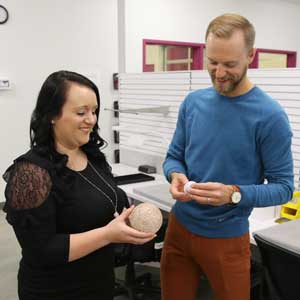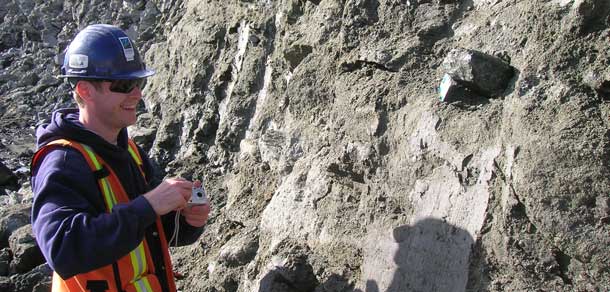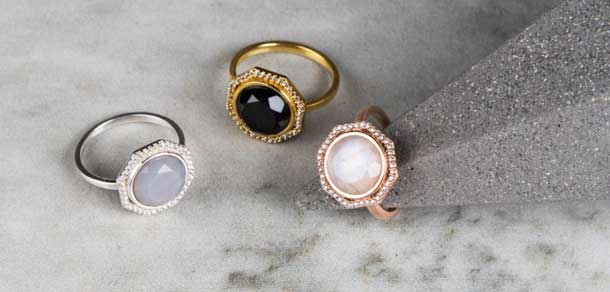There are few more dramatic Saskatchewan homegrown entrepreneurial success stories than the meteoric rise of Hillberg & Berk. The internationally renowned jewellery company has become a favourite of some of the biggest female celebrities, including Carrie Underwood, Sarah McLachlan, Michelle Obama, Barbara Walters, Celine Dion and, most notably, Queen Elizabeth II.
It’s hard to imagine a more storybook tale of business built from the ground up. Company founder Rachel Mielke has made jewellery as a hobby since high school. In college, she started to sell a few pieces to friends. In 2005, she tested the waters with a trade show where she sold thousands of dollars worth of pieces in one weekend. After that, she took the plunge to start her own company (originally named Urban Pearl). The brand and its unique jewellery designs became an overnight sensation which required Mielke to start a slow but steady course to expansion. In 2008, she appeared on CBC’s Dragon’s Den and secured a $200,000 investment from W. Brett Wilson, which she used for advertising, real estate, research and staff. Today the company does roughly $15 million in annual global sales and employs over 150 people.
Bring in the Engineers
 As her production has expanded from her kitchen table to factories, Mielke’s technological needs have changed. For that reason, industrial systems engineer Scott Kiefer, P.Eng. and chemical engineer Leslie Squire, P.Eng. have been added to the team to improve efficiency, capacity and quality control.
As her production has expanded from her kitchen table to factories, Mielke’s technological needs have changed. For that reason, industrial systems engineer Scott Kiefer, P.Eng. and chemical engineer Leslie Squire, P.Eng. have been added to the team to improve efficiency, capacity and quality control.
Kiefer was the first engineer hired with the company in 2016 and he recalls that, despite the company’s reputation for methodical decision making, the decision to bring him on as an engineer was done somewhat on the fly.
“I had originally applied for a job in their distribution division but then, as they started looking at my resumé, they became intrigued by the perspective an engineer could bring to their processes so they brought me on as production manager instead,” Kiefer says.
Kiefer’s job primarily involves planning the mass production of the jewellery pieces.
“The company previously didn’t do a lot of planning about how their pieces would make the transition from artistic design, where they are handcrafted, to larger limited runs. Now we are a liaison between the suppliers and the designers to find the best way to produce the piece so that it maintains artistic integrity yet is efficient to manufacture. It sometimes requires us to do some tweaking to the design,” Kiefer says.
Art and Craft
Achieving this requires a careful balancing act between the artistic mind and the engineering mind.
“You have to put yourself in artists’ shoes. Part of me wants to make the pieces as simple and easy to replicate as possible but that would diminish the artistic value of the pieces. We have to be aware, every bit as much as the designers are aware, of what the customers want. Essentially, we have to use engineering problem-solving skills to overcome artistic problems,” Kiefer says.
Quality Control
Squire was hired in early 2017. Kiefer was happy to have her on the team.
“It was pretty lonely there for a while being the only science guy on a team of artistic, marketing and finance people. It was good to have a fellow engineer on board.”
Squire’s work focuses mainly on quality control, using her skills to ensure consistency in the products delivered from manufacturing suppliers. However, she’s also been able to add to the quality and efficiency of the production process.
“Before Scott and I got here, the company had limited ability to liaise with suppliers about detailed product specifications. Now, rather than simply requested a ‘plated ring’, we’re able to drill down further into the technical specifications of the plating process so that we receive a product that has much more precise quality standards,” Squire says.
Squire has also worked with researchers at the University of Regina to develop improved techniques for carrying out testing and quality check on metals.
Customer First
Just like the designers and marketing team, the Hillberg & Berk engineers keep a close ear to the ground for feedback from customers.
“Everything we do has to be aimed at making a product with which the customers are happy. The company has an extensive system for gathering that information. Our marketing people do a lot of research in advance. We get daily reports from our front-line retailers about sales statistics and customer response. We do focus groups and testing. That all helps us ensure we are living up to the company’s quality standards,” Kiefer says.
Enhanced Analysis
Together the pair has helped the company improve its ability to roll out products and respond to markets.
“Before, the company was more at the mercy of suppliers so there wasn’t a clear sense of how long it would take to move a product from design stage through larger limited runs, which makes marketing planning more difficult. Now when they are planning a launch, we do more analysis upfront to tell them how long it will take to make and how much it will cost. But still the process isn’t always exact. In engineering we always want things to be perfect but sometimes you can’t make things perfect, so then you just have to use your skills to find a way to make things work,” Kiefer says.

